In our letter to the Florida Department of Corrections, we explain why cutting visiting hours is bad policy and an inhumane practice.
by Lucius Couloute,
May 31, 2018
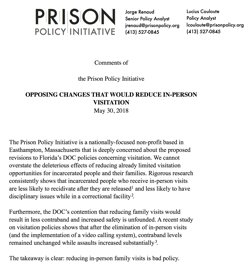
Florida’s Department of Corrections recently proposed new policies that would allow correctional facilities in the state to reduce their visitation hours by half, limiting opportunities for families to see their incarcerated loved ones in person. You’d be hard-pressed to find many people who actually believe reducing prison visits is a good idea, but the DOC has cited issues with contraband and staff costs as the impetus for the proposed changes.
Senior Policy Analyst Jorge Renaud and I wrote a comment letter opposing the proposed changes, citing established research that shows how reducing visitation is bad correctional policy. Moreover, we argued, it’s simply cruel:
Ensuring that incarcerated people maintain ample connection to the outside world is humane, cost-effective, and would result in less dangerous correctional facilities – to the benefit of everyone.
The plan to reduce these visits in favor of for-profit video chatting will undoubtedly force the families of incarcerated people to visit stale, flatscreen kiosks inside of correctional facilities, or to pay high fees when video chatting from home (a service that is usually free). Both options trivialize the importance of family relationships during periods of incarceration.
Reducing the opportunities incarcerated people have to see their families would be an unfortunate development in Florida’s justice system, which is already being criticized for cutting vital rehabilitative programs this year.
If Florida would like to reduce the need for visitation (because of costs or contraband), reducing the overall prison population would be a good start.
Update: check out journalist Ben Conarck’s twitter thread for coverage of a public hearing on visitation in Florida.
Our new Senior Policy Analyst brings a wealth of organizing, writing, and policy experience.
by Wendy Sawyer,
May 30, 2018
 Please welcome our new Senior Policy Analyst, Jorge Renaud.
Please welcome our new Senior Policy Analyst, Jorge Renaud.
Jorge’s new role marks a return to policy work after three years of community organizing, most recently at Grassroots Leadership in Austin, Texas. Jorge also holds a Master’s degree in Social Work from the University of Texas at Austin.
He is an accomplished writer: While incarcerated, he wrote as a contributing columnist for Hispanic Link Weekly Report, focusing on race and incarceration, published poetry and essays, and authored a book, Behind the Walls: A Guide for Families and Friends of Texas Prison Inmates.
At the Prison Policy Initiative, Jorge is focused on writing about criminal justice policy in ways that will fuel the work being done by those directly affected by the criminal justice system.
Welcome, Jorge!
In a first-of-its-kind data analysis, we explore the economics of prison commissaries in three states.
May 24, 2018
The ongoing – and growing – exploitation of incarcerated people and their families has been a central theme in our work at the Prison Policy Initiative. In our new report, attorney Stephen Raher explores another overlooked but central part of prison life: the commissary. The fairness of prison commissaries is an essential bread-and-butter issue for incarcerated people, who have only the store’s limited options to choose from when the prison fails to provide them with what they need.
In his report, The Company Store: A Deeper Look at Prison Commissaries, Raher analyzes commissary sales data from three states to address questions like:
- What do people spend the most money on in prison commissaries?
- How “fair” are prices, compared to “free-world” prices and relative to prison wages?
- How does the emerging digital market compare to traditional commissary sales, like food and toiletries?
The three states sampled – Illinois, Massachusetts, and Washington – were the few from which we could easily obtain detailed statewide commissary sales data. Fortunately, this sample includes examples of both state-run and privately operated commissary systems, as well as a range of prison population sizes. While we would warn against generalizing broadly based on this small sample, the report highlights a number of issues that merit further study and serious consideration by policymakers.
The purpose and fairness of prison commissary systems come into question in light of the report’s findings:
- Incarcerated people spent an average of $947 per person annually through commissaries – well over the typical amount they can earn at a prison job. In these three states, an incarcerated worker holding a job supporting the prison, such as food service or custodial work, would usually earn $180 to $660 per year.
- Incarcerated people buy most items to meet basic needs, like food, hygiene, and over-the-counter medicines, rather than “luxuries.” 75% of the average person’s annual commissary spending in the three sampled states was used to purchase food and beverages, indicating a widespread need to supplement the food provided by the prisons.
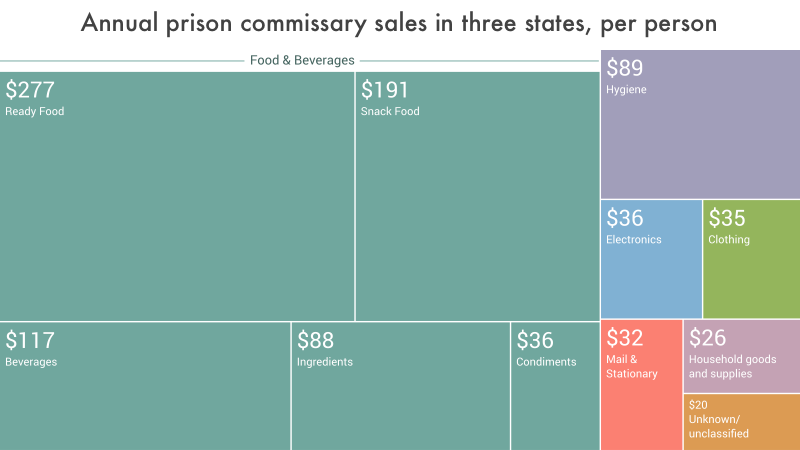
The findings also point to the incentives of the prison retail market for private commissary vendors:
- While private vendors generally charge prices comparable to those found in outside prisons, monopoly contracts and the ability to transfer goods straight from the warehouse to the customer mean vendors’ operating costs are often lower than in the “free world.” Yet their prices do not always reflect these advantages.
- The most obvious price-gouging is found in new digital services marketed to prisons, such as email and music streaming. Prison and jail telecommunications providers are aggressively pushing these new products and services, where they can charge prices far higher than similar businesses do outside of the prison setting.
- Even in state-run commissary systems, private companies are poised to profit. In Illinois, the Keefe Group (one of the largest commissary companies) was not contracted to run the commissary, but still made up the dominant share (30%) of the state’s purchases for commissary goods.
Commissaries present yet another opportunity for prisons to shift the costs of incarceration to incarcerated people and their families. Meanwhile, telecommunications contractors with prison contracts are maximizing their revenues by offering more digital services at exorbitant rates. Instead of leveraging incarcerated people to subsidize the prison system by monetizing their every need, the report concludes, states could more effectively cut costs by drastically reducing prison populations.
Mass incarceration intensifies the financial and social burdens that already fall too hard on women.
by Lucius Couloute,
May 14, 2018
1 in 4 women in the U.S. – and nearly 1 in 2 Black women – have a loved one who is incarcerated, but even in conversations about ending mass incarceration, the hardships these women face get little attention. A new report from the Essie Justice Group exposes the profound isolation that is experienced by these women and ignored by the rest of society.

Essie surveyed over 2,000 women and collected a wealth of focus-group and interview data, all aimed at uncovering the experience of being a woman with an incarcerated loved one. We partnered with Essie to help analyze this data. Our work produced disturbing findings: Not only do women with incarcerated loved ones feel stigmatized and isolated; they also disproportionately suffer from financial insecurity, homelessness, and serious mental and physical health problems.
Women provide their incarcerated loved ones with numerous types of support, which can include posting bail or paying burdensome court fees. Shouldering these burdens often destabilizes their lives: Fully 43% of the women Essie surveyed had missed out on educational opportunities, changed their career plans, or taken on longer hours as the result of their loved one’s incarceration. More than half of them had childcare responsibilities as well.
It’s clearer than ever that overpolicing and overcriminalization – far from making families safer – creates anxiety and insecurity for the mothers, wives, and sisters of people behind bars. Women with incarcerated loved ones are isolated politically, not just socially. Listening to their experiences is critical to understanding how mass incarceration devastates entire communities.
80% of the women jailed each year are mothers. We're inflicting profound damage not only on them, but their children as well.
by Wendy Sawyer and Wanda Bertram,
May 13, 2018
This report is has been updated with a new version for 2022.
Women incarcerated in the U.S. are disproportionately in jails rather than prisons, and even a short jail stay can be devastating, especially when it separates a mother from children who depend on her.
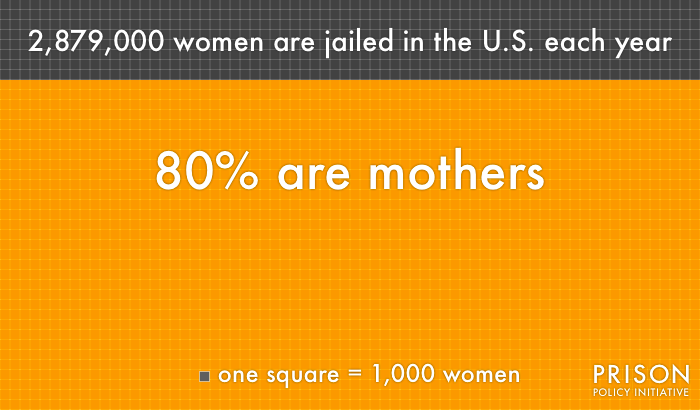 Estimates have been rounded for this graphic. Sources: Federal Bureau of Investigation, Crime in the United States 2016 (including supplemental table “Arrests by Sex, 2016”); and Vera Institute of Justice, Overlooked: Women in Jails in an Era of Reform.
Estimates have been rounded for this graphic. Sources: Federal Bureau of Investigation, Crime in the United States 2016 (including supplemental table “Arrests by Sex, 2016”); and Vera Institute of Justice, Overlooked: Women in Jails in an Era of Reform.
80% of the women who will go to jail this year are mothers – including nearly 150,000 women who are pregnant when they are admitted. Beyond having to leave their children in someone else’s care, these women will be impacted by the needlessly brutal side effects of going to jail: Aggravation of mental health problems, a greater risk of suicide, and a much higher likelihood of ending up homeless or deprived of essential financial benefits.
It’s time we recognized that when we put women in jail, we inflict potentially irreparable damage to their families. Most women who are incarcerated would be better served though alternatives in their communities. So would their kids.
For nearly a year, the FCC knew about Securus’s cellphone tracking and turned a blind eye.
by Aleks Kajstura,
May 11, 2018
Abuse of power in the nation’s prison and jails is nothing new, but now correctional staff can target any person in the U.S. – as long as that person has a cell phone. Last night, The New York Times reported that Securus allows facility staff to track any cell phone in the country.
Securus has contracts with hundreds of correctional and law enforcement agencies across the country, meaning that staffers at any of these agencies can track you on a whim. Shouldn’t they at least have a warrant or affidavit if they want to track your cell phone? Absolutely – but Securus isn’t checking. What if you never even talked to anyone in any correctional facility? Securus doesn’t check on that, either.
As the Times reports, Senator Ron Wyden (D-OR) sent a letter to the FCC asking them to investigate, as well as letters to phone companies like Verizon and AT&T, who provide the tracking data to Securus.
The thing is: the FCC already knew about this. When Securus was up for sale last year, Lee Petro, representing the Wright Petitioners, pointed to this very practice as a reason for the FCC to block the sale. But the FCC turned a blind eye.
Thanks to Senator Wyden’s letters, Verizon, AT&T, Sprint, and T-Mobile are starting to ask their own questions. But it’s a sad day when the FCC has to rely on telecom giants to carry out its mandate.
Homicide victimization rates for Black men, Black women and Indigenous women are consistently higher than for other racial and ethnic groups.
by Emily Widra,
May 3, 2018
I wanted to compare homicide victimization across racial, ethnic, and gender groups over time, since this data is deceptively difficult to find in one place.
In the process, I found that the murder victimization rate for Black men is consistently higher than the rates for men of all other racial and ethnic groups have ever been:
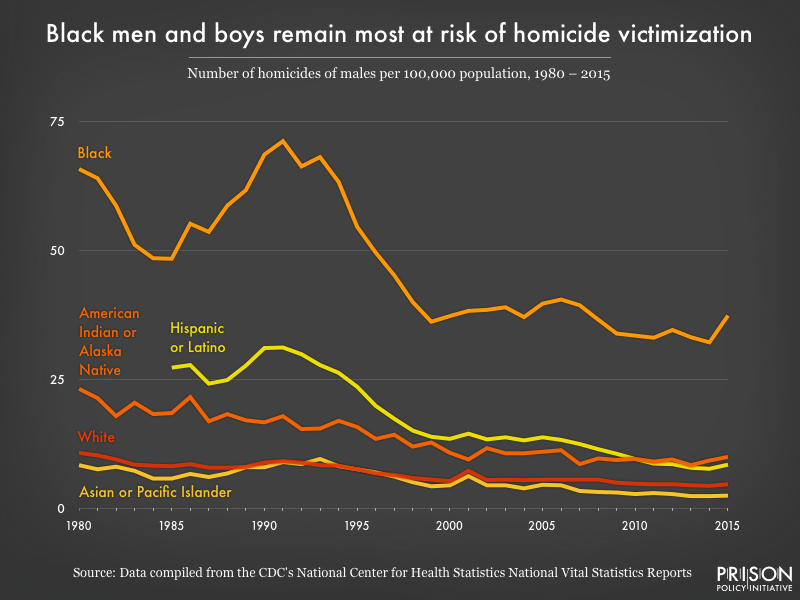 Despite a drop in overall murder rates, the racial disparities in male murder victimization rates have persisted.
Despite a drop in overall murder rates, the racial disparities in male murder victimization rates have persisted.
Controlling for gender reveals more complexity. For example, the rate of homicide of Indigenous women is higher than the rate of homicide for Hispanic and Latina women, whereas the opposite is true for their male counterparts:
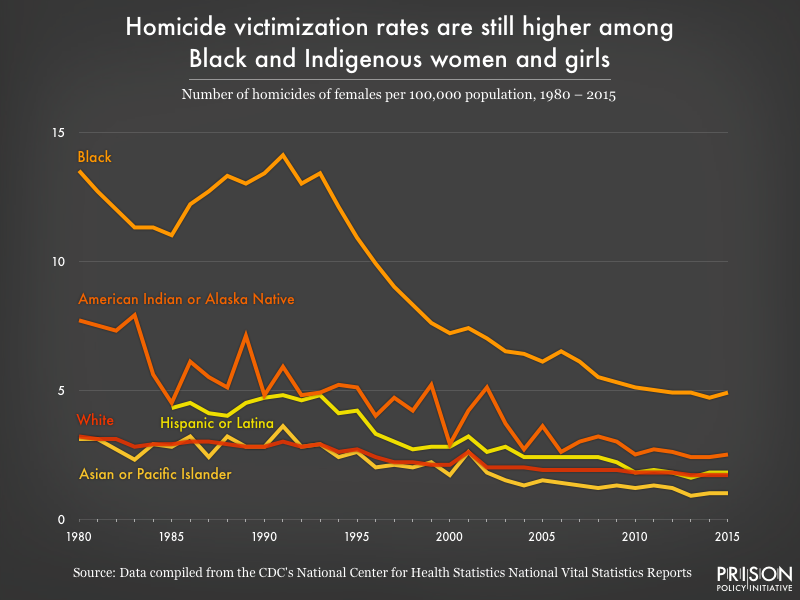 Overall, Black, Hispanic or Latinx, and American Indian and Alaskan Native people are murdered at much higher rates than their white or Asian and Pacific Islander counterparts.
Overall, Black, Hispanic or Latinx, and American Indian and Alaskan Native people are murdered at much higher rates than their white or Asian and Pacific Islander counterparts.
Overall murder rates have been declining since 1980, when the total rate for murder and non-negligent manslaughter was 10.2 per 100,000 people. But the disproportionately high rate at which Black Americans are murdered should still concern lawmakers, reporters, and the public.
Unfortunately, conversations about about this problem often fall back on the assumption that violence in Black communities has cultural — or even biological — roots. But these assumptions aren’t supported by data.
For instance, Krivo and Peterson’s analysis of crime data in Columbus, Ohio shows that economic disadvantage, not race, is the strongest predictor of violence in a particular neighborhood. “In fact,” they conclude, “violent crime rates for extremely disadvantaged white neighborhoods are more similar to rates for extremely disadvantaged black areas than to rates for other types of white neighborhoods.”
Studies like these suggest that racial disparities in murder rates stem from a variety of structural causes, most notably economic inequality. (To dig deeper, see Krivo and Peterson’s study controlling for neighborhood disadvantage, as well as the Violence Policy Center’s recent study of Black homicide victimization.)
Comparing violent crime rates to public opinion data shows that there's a long-standing disconnect between perception and reality.
by Emily Widra,
May 3, 2018
I updated a graph from our 2003 book The Prison Index to answer the question: How closely does Americans’ fear of violent crime reflect the actual violent crime rate?
The answer: Hardly at all.
Beginning in 1965, Gallup began asking Americans if there was “any area near where you live…where you would be afraid to walk alone at night?” Over time, these poll results show a tenuous relationship, at best, between the violent crime rate and the number of people who report being afraid:
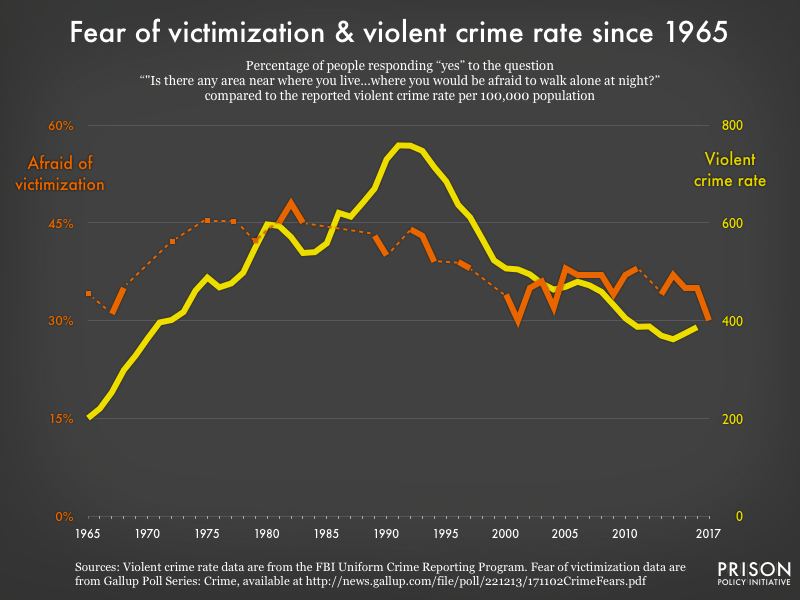 The violent crime rate (yellow) peaked in 1991. The fear of crime (orange) peaked nine years earlier and was already declining when the violent crime rate was approaching its peak.
The violent crime rate (yellow) peaked in 1991. The fear of crime (orange) peaked nine years earlier and was already declining when the violent crime rate was approaching its peak.
Of course, this data isn’t sensitive to regional and economic variations in crime across the country. And people who aren’t afraid of being attacked might be afraid to walk around at night for other reasons.
But it’s interesting to explore the discrepancy between perception and reality. From the early 1980s to the early 1990s, as violent crime reached historic heights, Americans’ fear of victimization fell.
This isn’t to say that Americans are grossly out of touch. But it should remind elected officials and media that the last place to look for evidence of a crime wave is in public opinion polls.

 Please welcome our new Senior Policy Analyst, Jorge Renaud.
Please welcome our new Senior Policy Analyst, Jorge Renaud.

 Estimates have been rounded for this graphic. Sources: Federal Bureau of Investigation,
Estimates have been rounded for this graphic. Sources: Federal Bureau of Investigation,  Despite a
Despite a  Overall, Black, Hispanic or Latinx, and American Indian and Alaskan Native people are murdered at much higher rates than their white or Asian and Pacific Islander counterparts.
Overall, Black, Hispanic or Latinx, and American Indian and Alaskan Native people are murdered at much higher rates than their white or Asian and Pacific Islander counterparts. The violent crime rate (yellow) peaked in 1991. The fear of crime (orange) peaked nine years earlier and was already declining when the violent crime rate was approaching its peak.
The violent crime rate (yellow) peaked in 1991. The fear of crime (orange) peaked nine years earlier and was already declining when the violent crime rate was approaching its peak.


